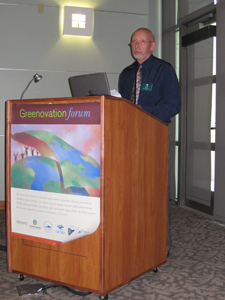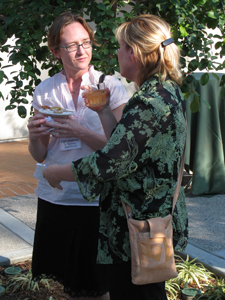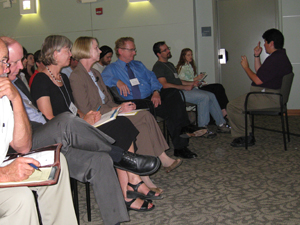Experts Explore Socio-Economic and Environmental Impacts of Water Use at UCSD's Greenovation Forum
By Tiffany Fox, (858) 246-0353, tfox@ucsd.edu
San Diego, CA, Oct. 6, 2008 — Historian Thomas Fuller once remarked, "We never know the worth of water 'til the well is dry." With that admonition in mind, Professor Paul Linden, director of UCSD's Environment and Sustainability Initiative (ESI), kicked off this year's Greenovation Forum, a series of wide-ranging presentations about the importance of water on both a regional and global scale. The annual forum is organized by ESI with funding from the Scripps Foundation for Science and the Environment to showcase research at UCSD that has the potential to contribute to sustainability solutions, and to promote deeper interaction between academic, public, private and non-profit sectors.
|
The first event in this year's forum was held last week at UCSD's Atkinson Pavilion, and focused on "Water Issues Everywhere," a nod to water's instrumental role not only in terms of health and household, but also transportation and energy. Presenting first was Professor Steve A. Kay, Dean of Biological Sciences at UCSD, who illustrated the tenuous relationship between water supplies and biofuels in a lecture titled "Biofuels: Hope, Hype and Hydration."
Noting the explosion in global population and the increasing concerns about climate change and national energy security, Kay suggested "we need advanced, sustainable biofuel technology to replace fossil fuels." But even among sources of biofuel, Kay says "there is no silver bullet."
"We have to be thinking about silver buckshot," he cautioned, coining a phrase that would turn up again several times during the forum.
Perhaps the most well-known biofuel is ethanol, which is commonly derived in the U.S. from a portion of the country's huge output of corn (according to Kay, 97 million acres of the crop were grown in the U.S. in 2008 alone).The U.S. government's energy policy now mandates that industry generate 30 billion gallons of ethanol by 2020, which poses "a huge challenge in terms of water use," Kay said.
"The average corn ethanol plant uses 100 million gallons of water per year, or the same amount as a town with 5,000 people," he remarked, adding that there are also water quality issues associated with the waste stream from ethanol plants — typically, crop fertilizers that end up in groundwater supplies, and eventually, the world's oceans.
Scientists at UCSD are researching an alternative to corn ethanol known as lignocellulosic biomass. The term refers to several categories of biomass, including wood residues (sawmill and paper mill discards), municipal paper waste, agricultural residues (from corn and sugarcane crops) and dedicated energy crops made of fast-growing, woody grasses. This biomass is converted into sugar, and finally, into ethanol, and creates far fewer pollutants and carbon dioxide — and requires less water — than does corn ethanol.
Kay added that lignocellulosic biomass also eliminates social anxieties over the potential "food vs. fuel" scenarios that corn ethanol poses, "especially in heavily irrigated California," which already relies on outside water supplies to grow many of its crops. By way of example, he showed the audience a political cartoon depicting a starving child eating from a corn cob. A man looming above the child reaches for the corn, saying "Excuse me, I'm going to need this for my car."
The good news for corn ethanol is that farmers are using precision agriculture and methods such as terracing and plant breeding to reduce the land and water required to grow and process a bushel of corn. But an even more efficient biomass alternative might prove to be the use of micro-algae, otherwise known as "pondus scumus," joked Kay. Micro-algae can be grown far more densely than corn or soy (thereby reducing the space required for cultivation) and can be grown in water three times more saline than ocean water.
"Saline water is plentiful even in arid regions," Kay noted. "Not only that, ethanol made from micro-algae has much better energy density than corn ethanol and is not associated with the same environmental problems."
|
Whatever the ultimate solution, it's likely to be developed, at least in part, by one of the 30,000 scientists and industry partners working on biofuels research with a 4-mile radius in La Jolla, Calif., the home of UCSD. More than 8 companies and 11 centers both on- and off-campus — including the UCSD division of the California Institute for Telecommunications and Information Technology (Calit2), which houses ESI — are actively researching biofuel technology, Kay said.
Following Kay's presentation was a lecture by Maureen Stapleton, the general manager of the San Diego County Water Authority (SDCWA), the regional water agency that provides 97 percent of all the water used by San Diego County's 3 million residents. Stapleton said that the biggest challenge her organization faces is that "people think water is their birthright."
"Your cable bill is probably more expensive than your water bill," she mused. "And when that happens, you don't care enough to conserve."
But times are changing, Stapleton said. Reservoirs at Lake Powell and Lake Mead are at half capacity, and the declining population of Delta Smelt — an environmental "indicator species" of fish — has led to severe restrictions on pumping in the Sacramento Bay Delta, where a large percentage of San Diego's water originates. The Colorado River, which is shared by seven "basin states," including California, is oversubscribed, and there are indications that the snow pack will be reduced over the next 50 to100 years. Compounding all of that is the drought that has affected the region for eight consecutive years, making "the last two years the driest in San Diego since Thomas Jefferson was president," Stapleton remarked.
"Our biggest fear is that this is no longer a drought, but a movement into a different climate," she added. "Our future will look nothing like our past did. So let me be really clear: Your water rates are going up. There's no doubt."
Those rate hikes will be decided on a "tiered billing" basis, Stapleton said, meaning consumers who conserve water will be billed less than, say, a neighbor who waters his lawn twice a day. To further reduce water consumption, the SDWCA has issued a 20-gallon challenge, which encourages residents to save 20 gallons of water per person per day, and through the Colorado River Quantification Settlement, it has offered farmers cash compensation for conserving water. If needed, the SDCWA will also issue new regulations and standards pertaining to building, landscaping, production and use, Stapleton said.
Despite San Diego's water challenges, the SDCWA has taken measures to improve its supplies and reduce reliance on water from far-flung locales. Stapleton notes that in 1991, only 5 percent of San Diego's water was from local sources, but now that number is 40 percent. By 2020, she expects the Authority to have "a fully diversified water portfolio," including a mix of imported water, local water, desalination of brackish groundwater and ocean water and reclamation (direct use of recycled water and indirect potable reuse).
|
On the minds of the two respondents at the forum — C. Gary Gelines, founder and CEO of water management company Water2Save, and Marty Eberhardt, executive director of Cuyumaca College's Water Conservation Garden -- was San Diego's proclivity for elaborate landscaping. Gelinas noted that 50 to 70 percent of the water in San Diego is used for outdoor watering, but with education and reform, he said he sees "the potential for our landscapes to be something more sustainable."
"In San Diego," Eberhardt added, "people haven't really gotten the idea that they live in an arid environment because they've been able to grow whatever they want. But education can give us a sense of place about where we live. We live in San Diego, not Hawaii."
Topics for future Greenovation Forums include:
- "Impacts of Climate Change on Water in San Diego" (Dec. 9), which will examine how climate change might affect water resources in San Diego County, and how citizens and businesses are adapting to prevent future water shortages
- "Biofuels" (Feb. 10, 2009), a look at large-scale, marine production of algae, which is emerging as a viable source for biofuels
- "New Sources of Water — Desalination to Re-Use (March 2009), which will explore opportunities for new sources of fresh water (held in conjunction with the San Diego Science Festival)
- "The Value of Water" (April 2009), a conversation about what motivates people to conserve water and what value people place on water
- "The Water We Eat" (May 2009), an exploration of the role of water in the production of food.
Media Contacts
Tiffany Fox, (858) 246-0353, tfox@ucsd.edu
Related Links
UCSD's Environment and Sustainability Initiative
UCSD Division of Biological Sciences
San Diego County Water Authority
Water2Save
Cuyumaca College Water Conservation Garden




